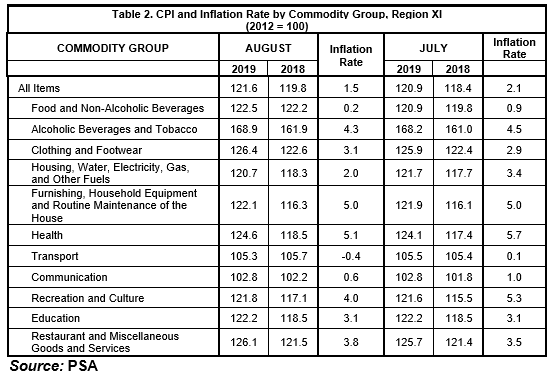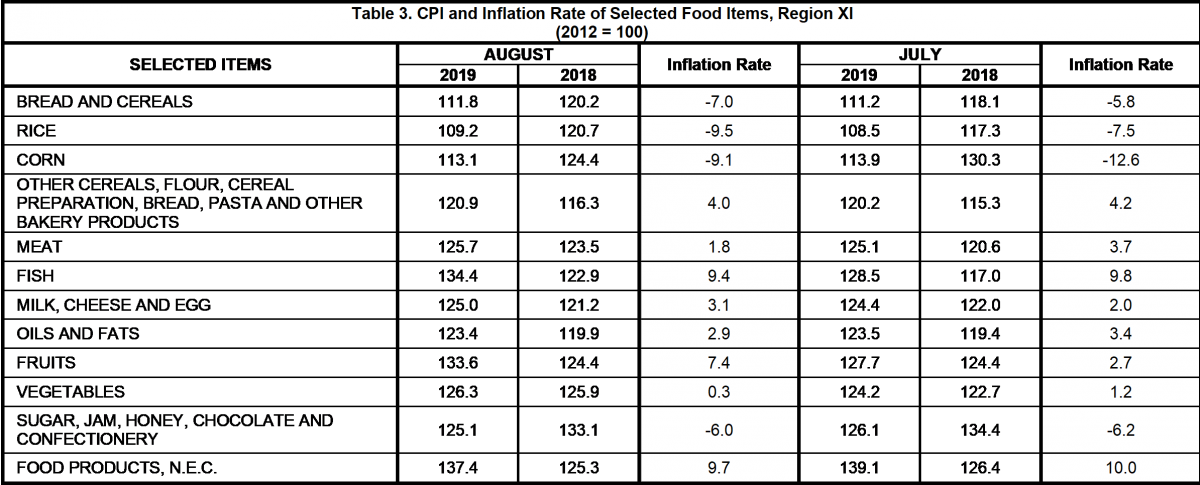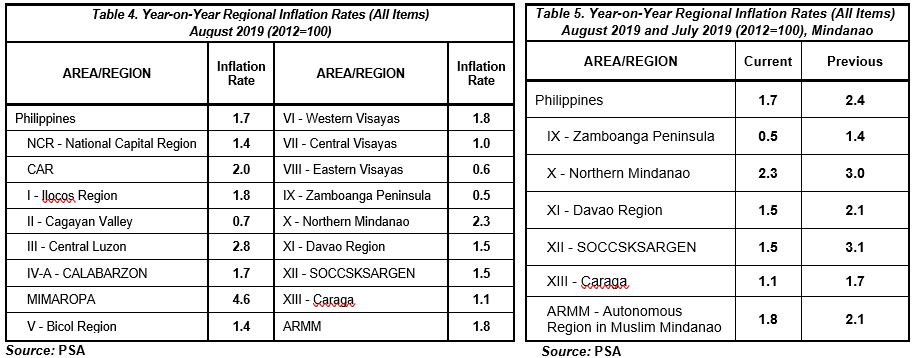Release Date :
Reference Number :
2019-012
 Davao Region’s inflation slowed further to 1.5 percent in August 2019. This is the lowest inflation recorded in Davao region since January 2016, in which the inflation rate was 2.3. Relatedly, purchasing power of peso (PPP) remained at 83 centavos.
Davao Region’s inflation slowed further to 1.5 percent in August 2019. This is the lowest inflation recorded in Davao region since January 2016, in which the inflation rate was 2.3. Relatedly, purchasing power of peso (PPP) remained at 83 centavos. Expectedly, Inflation rates per province went down, with Davao Oriental having the lowest inflation at negative 0.7 percent, followed by Davao Del Norte (0.9%), and Compostela Valley (1.9). On one hand, Davao Del Sur continued to have the highest inflation in the region at 2.0 percent (see Table 1).
Deceleration of inflation was primarily attributed to the slower annual increment of almost all of indices, particularly Housing, Water, Electricity, Gas, and Other Fuels which were at 1.4, and Recreation and Culture at 1.3 percent. (see Table 2). The following commodity groups also contributed to the deceleration of inflation:
• Food and Non-Alcoholic Beverages, 0.2%;
• Health, 5.1%;
• Transport -0.4%;
• Communication, 0.6%; and
• Alcoholic Beverages and Tobacco, 4.3%
On the other hand, Restaurant and Miscellaneous Goods and Services, and Clothing and Footwear, showed a slight increase of 3.8% and 3.1% respectively, while Furnishing, Household Equipment and Routine Maintenance of the House and Education retained its previous month’s annual rate (see Table 2).

Selected food items that showed slower annual increase were reported in Rice (-9.5% from -7.5% percent); Meat (1.8% from 3.7%); and Bread and Cereals (-7.0% from -5.8%). At the same time, food items such as Vegetables; Oils and Fats; Fish; Food Products, N.E.C.; and Other Cereal, Flour, Cereal Preparation, Bread, Pasta, and Other Bakery Products also displayed slower annual growth.
A significant increase on selected food items were recorded in Fruits at 7.4 percent from 2.7 percent; and Corn at negative 9.1 percent from negative 12.6 percent in the previous month. Other food items such as Sugar, Jam, Honey, Chocolate and Confectionery; Milk, Cheese and Egg Other food also exhibited an increase in its indices.

Among administrative regions, MIMAROPA’s inflation decreased from 4.9 percent to 4.6 percent for the month of August but remained to be the region with the highest inflation, while Zamboanga Peninsula holds the lowest inflation at 0.5 percent. Moreover, region with lower rates than the national inflation was National Capital Region (NCR), Cagayan Valley, Bicol Region, Central and Eastern Visayas, Zamboanga Peninsula, Davao Region, SOCCSKSARGEN, and Caraga while regions with higher inflation were CAR, Ilocos Region, Central Luzon, MIMAROPA, Western Visayas, Northern Mindanao and ARMM (see Table 4).
In Mindanao regions, inflation in six administrative regions had decelerated, but among these regions, Northern Mindanao hit the highest inflation at 2.3 percent, while Zamboanga Peninsula continued to be the region with the lowest inflation at 0.5. percent (see Table 5).

Approve for Release:
PEPITO D. AMOYEN
(Chief Statistical Specialist)
Officer-in-Charge
PSA Regional Statistical Services Office XI
